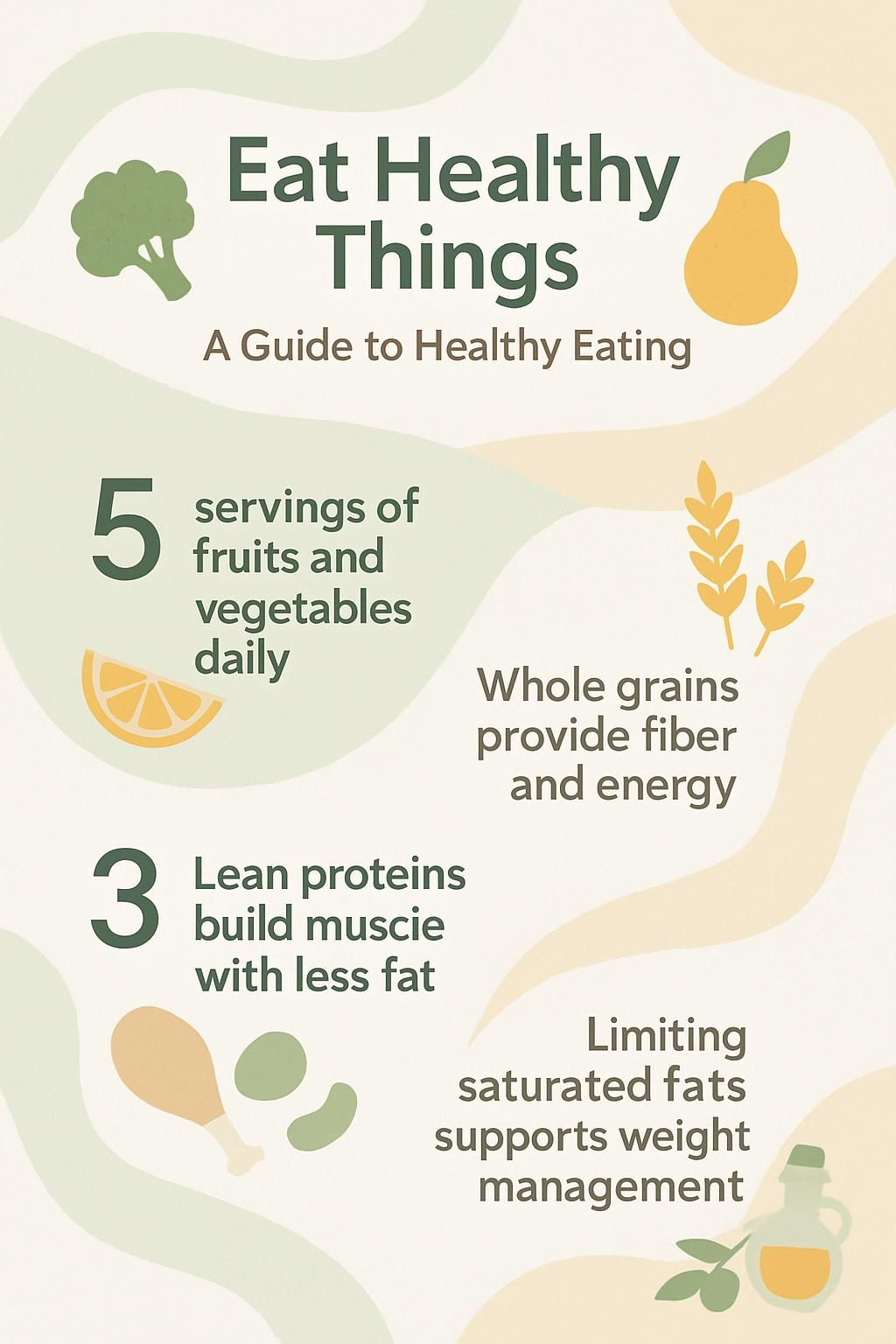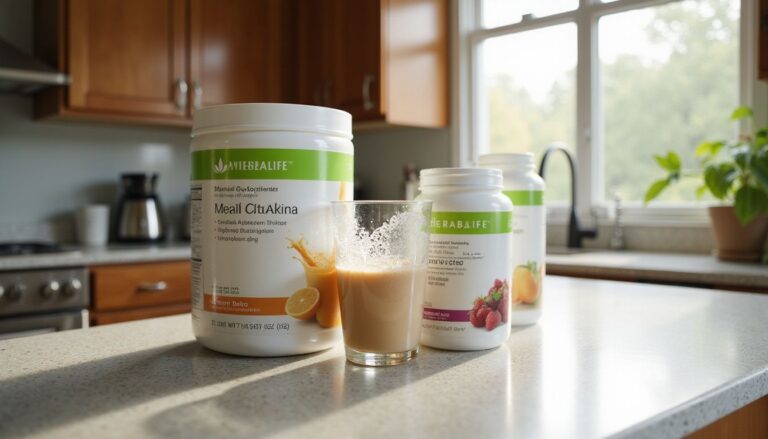Eat Healthy Things: A Guide To Healthy Eating
Our Nutrition Assistant AI Suite will transform your body. You will lose fat, get toned, and build muscle. Gain confidence and optimal health.
If you feel unsure about what counts as healthy foods, you are in good company. Many people want a healthy diet but feel lost in the mix of food groups and claims. A simple start is this, build meals around fruits, vegetables, whole grains, lean proteins, and healthy fats. This healthy eating pattern supports your heart health and helps you reach a healthy weight.
In this guide, you get clear, evidence-based tips. You will learn why healthy eating matters, which foods support your body, how to read a nutrition facts label, and how to plan meals you will actually cook. Take one small step today. Small changes add up fast.
Key Takeaways
- Eating at least five servings of fruits and vegetables each day can lower the risk of heart disease, stroke, some cancers, and other chronic conditions (CDC Healthy Eating).
- Whole grains like brown rice and oats provide steady energy, fiber, and B vitamins that support digestion and metabolism.
- Lean proteins, for example chicken breast, salmon, eggs, beans, and lentils, build muscle with less saturated fat than fattier meats or processed options.
- Limiting saturated fat, added sugar, and sodium, and reading labels, supports healthy weight management and cuts the risk of obesity-related disease (Harvard T.H. Chan School of Public Health).
- Varied diets rich in fruits, vegetables, lean protein sources, whole grains, nuts, and seeds are linked with better mental well-being and stronger physical health.

What makes a food healthy?

Healthy foods are mostly whole foods. Think fresh or frozen fruits and vegetables, beans and lentils, plain yogurt, fish, and nuts. These choices deliver vitamins, minerals, and fiber while staying low in saturated fat, added sugar, and excess sodium.
Examples like sweet potatoes and broccoli bring fiber and key vitamins that support heart health. Dietitians and the American Heart Association highlight these foods for good reason. They feed your body what it needs.
Healthy choices also bring protective plant compounds. Antioxidants and phytonutrients help defend your cells. Oily fish, such as salmon, offer omega-3 fatty acids, which support your heart and brain. Low-fat dairy gives calcium for bones, and beans bring plant protein plus iron and fiber.
In 2021, researchers scored many food groups across dozens of nutrition attributes. Top categories included legumes, vegetables, fruits, whole grains like quinoa and brown rice, seafood rich in healthy fats, and nuts and seeds. These groups rose to the top because they pack dense nutrition per bite.
Many whole foods come without artificial sweeteners or fillers. You can see benefits quickly once you build balanced plates around these staples. Next, you will see how these choices pay off for your health.
What are the benefits of eating healthy?
Eating a nutritious diet gives your body the raw materials it needs. Calcium supports bones, fiber aids digestion and helps manage cholesterol, and protein repairs tissues. These habits also lower risk factors tied to obesity and other chronic conditions.
How does healthy eating improve physical health?
Five portions of fruits and vegetables a day can lower your risk of heart disease, stroke, and certain cancers. Choosing unsaturated oils, like olive or canola oil, can help reduce LDL cholesterol, the type linked with plaque in arteries.
Low-fat dairy provides calcium and protein for strong bones and muscles. Limiting foods high in saturated fat helps keep cholesterol under control and supports heart health.
Beans, lentils, fish, eggs, poultry, and lean meats supply vitamins and minerals for growth and repair. These foods also deliver protein that helps maintain muscle strength.
Following the Dietary Guidelines for Americans promotes variety across food groups. You will cover nutrients like potassium, fiber, and vitamin C to support your circulatory system, skin, and immune health.
A varied daily diet filled with fruits, vegetables, lean proteins, whole grains, and healthy fats supports every part of your body.
How does healthy eating enhance mental well-being?
Food fuels your brain too. Leafy greens, nuts, fruits, and vegetables deliver B vitamins, magnesium, and antioxidants that support mood. Surveys such as the 2019 Food Safety and Nutrition Survey showed clear links between eating patterns and mental health in U.S. adults.
Omega-3 fatty acids in salmon and walnuts may lower the risk of depression. Pairing protein with plants, like eggs on a salad or beans with whole grains, keeps your blood sugar steady. Stable energy supports focus at school or work.
Nutrition is a key part of mental well-being. Healthy meals help you feel more even, more alert, and better able to handle stress.
How does healthy eating increase energy levels?
A healthy eating pattern promotes steady energy. The best sources include whole grains and starchy foods, such as oats, brown rice, and whole wheat pasta. Experts suggest that a little over one third of your plate come from these foods.
Whole grain bread and potatoes with the skin provide fiber and B vitamins like thiamine. These nutrients help your body turn food into fuel. The result feels like a slow, even burn instead of a spike and crash.
High fiber and protein foods, such as oats and lentils, slow digestion, which keeps blood sugar stable. This helps you avoid the quick crash that follows sugary snacks and soft drinks.
During illness or recovery, nutritious meals support your energy needs as well. Even simple swaps, like whole grain bread instead of white bread, can reduce midafternoon slumps.
How does healthy eating support a healthy weight?
Balanced meals help you manage body weight. Foods that are high in fiber and protein, such as vegetables, beans, and lean proteins, keep you satisfied longer. That makes it easier to avoid extra calories from sweet or salty snacks.
Portion control also matters. Tools like MyPlate, from the United States Department of Agriculture, show how to build a balanced plate. A simple guide helps, a palm of chicken for protein, a fist of brown rice for grains, and a thumb of oil or dressing for fats.
Nuts, including almonds, may aid weight control. In 2023, Baer and colleagues found that almond snacks improved appetite control compared with many standard snacks. Small habits matter. An example: oatmeal with berries instead of cake after dinner gives sweetness with fiber, not a sugar surge.
These steps give you structure with room for foods you enjoy. That balance helps you stick with the plan.
How does healthy eating reduce the risk of chronic diseases?
Healthy eating patterns are linked with lower risks of heart disease, type 2 diabetes, some cancers, and chronic kidney disease. Reducing high sugar intake helps prevent obesity and dental problems.
Eating less sodium supports healthy blood pressure. That reduces the chance of stroke and heart attack. Choosing low-fat or fat-free dairy gives calcium without extra saturated fat. Some studies suggest full-fat dairy may raise risk for heart disease in certain people, so aim for lower fat options unless your clinician advises otherwise.
Oily fish bring omega-3 fats that help calm inflammation and protect your heart. Replacing shortening or hard stick margarines with olive or canola oil can improve your cholesterol profile.
Across the week, include colorful produce, nuts and seeds, a variety of protein sources such as chicken breast and legumes, whole grains like quinoa and oats, and leafy vegetables. These foods bring vitamins A and C, potassium, zinc, and other minerals your body needs to stay healthy.
Adding more greens, such as broccoli, increases fiber and phytochemicals. These plant compounds may help protect against certain cancers. Many people also report more consistent energy after boosting veggie intake.
Building a balanced diet
Building a balanced diet helps you cover your nutrient needs without overdoing calories. Federal guidelines encourage you to eat from each major food group and rotate your choices through the week.
Why is variety important in a balanced diet?
Variety protects you from nutrient gaps. Each food group brings something different. Fruits such as strawberries bring vitamin C and fiber. Lean proteins support muscle tissue and enzymes, the tiny helpers that run your metabolism.
The Eatwell Guide encourages at least five different portions of fruits and vegetables per day. Mixing plant and animal proteins, or pairing plant proteins such as beans and grains, helps you cover essential amino acids. These are the building blocks your body cannot make on its own.
Choosing across food groups also keeps sodium and saturated fat in check. Diets with diverse, whole foods have been linked with lower risk of heart disease and other chronic illnesses over time.
A simple habit can help. Aim for different colors on your plate. Greens like cabbage, reds like tomatoes and peppers, tan whole grains like oats or brown rice, plus healthy fats such as avocado or extra-virgin olive oil. Many people notice better energy after two or three weeks of this approach.
How can I understand portion sizes?
Your hand is an easy guide you can use anywhere. The University of Minnesota Extension suggests using your palm for a serving of lean protein, your fist for a serving of grains or starchy vegetables, and a cupped hand for a portion of nuts or seeds.
For fruits, one apple, banana, or pear counts as one serving. You can also weigh about 80 grams for a standard portion of fruit or vegetables if you have a kitchen scale.
Keep dried fruit to roughly 30 grams because it is concentrated in sugar. For juice or smoothies, 150 milliliters counts as a portion, but limit to once per day to reduce added sugar exposure.
Visual tools help too. Check resources with pictures of portions from each food group. As you learn the basics of macronutrients and micronutrients, you will build plates that satisfy and nourish.
What roles do macronutrients and micronutrients play?
Macronutrients are protein, carbohydrates, and fats. Protein builds and repairs tissues. Carbohydrates break down into glucose, the main fuel for your brain and muscles. Fats also provide energy and help you absorb vitamins A, D, E, and K.
Focus on healthy fats such as monounsaturated fats in nuts, seeds, avocado, and extra-virgin olive oil. Omega-3 fatty acids from salmon and other oily fish support heart and brain function.
Micronutrients are vitamins and minerals that you need in small amounts. Calcium supports strong bones and teeth, and dairy is a common source. Nuts and seeds provide magnesium for muscle and nerve function. Potassium from bananas and many vegetables helps control blood pressure. Vitamin C supports immunity and collagen, the protein that supports your skin and joints.
Water is essential for digestion, circulation, and temperature control. Fiber from leafy vegetables and whole grains supports a healthy gut. Many people notice steadier energy when they shift toward whole foods.
Healthy food groups to include
Cover these groups across your day to support health from many angles. Balance comes from variety, not perfection.
Why should I eat fruits and berries?
Fruits and berries supply fiber, vitamin C, potassium, and antioxidants that protect your cells. Eating at least five varied portions of fruits and vegetables per day is linked with lower risk of heart disease and some chronic illnesses.
Use 80 grams for one portion of fresh, frozen, or canned fruit packed in water or its own juice. For dried fruit, a small 30 gram serving is enough. A small glass of 100 percent fruit juice or smoothie, about 150 milliliters, counts only once per day because of sugar content.
Build variety with apples, oranges, bananas, blueberries, grapes, kiwi, pears, pineapple, raspberries, strawberries, and avocado. Olives add healthy fats and can lift the flavor of salads and grain bowls.
Dried fruit is handy but calorie dense. Keep portions small to avoid extra sugar. Fresh fruit shines as a snack, a topper for oatmeal, or a sweet finish to a meal.
Why should I eat vegetables?
Vegetables are nutrient dense, which means many nutrients for few calories. They are packed with fiber, vitamins, and minerals like potassium and folate. A mix of colors brings a mix of benefits.
Good options include broccoli, carrots, kale, bell peppers, squash, cabbage, and artichokes. People who eat enough vegetables tend to have lower risk of heart disease and stroke.
Aim to fill just over one third of your plate with vegetables at most meals. Three heaping tablespoons of mixed vegetables count as one portion. Brussels sprouts and Swiss chard are great ways to add variety and support long-term healthy habits.
Why include whole grains?
Whole grains keep their fiber and vitamins, so they deliver steady energy. Brown rice has more fiber and minerals than white rice. Oats contain beta-glucans, a type of fiber that helps lower LDL cholesterol and supports gut health. Quinoa provides plant protein and minerals like magnesium.
Replacing refined grains with whole grains can help you feel satisfied longer and reduce energy dips. Many students and busy workers find that a bowl of oatmeal keeps them focused through the morning.
Why choose lean proteins?
Lean proteins give your body amino acids for muscle building and repair without too much saturated fat. Chicken breast and lean beef are strong options. The Dietary Guidelines for Americans recommend at least two servings of seafood per week, including one serving of oily fish such as salmon for omega-3s.
Beans, lentils, and other pulses provide protein, iron, and fiber. Eggs supply complete protein and fit easily into any meal. In many cases, shifting from processed meats to lean options improves energy after lunch and keeps total calories in check.
Why are healthy fats important?
Healthy fats are key for hormone production, brain function, and vitamin absorption. Oils rich in monounsaturated fat, such as extra-virgin olive oil, support heart health and provide antioxidants.
Avocados supply healthy fats plus fiber and potassium. Walnuts and macadamia nuts add monounsaturated fats that can help maintain healthy cholesterol levels. Coconut oil contains medium-chain triglycerides, or MCTs, which are used quickly for energy, but it can raise LDL cholesterol, so use it sparingly.
All fats are calorie dense. Measure servings so snacks do not grow without noticing. A small handful of nuts is usually enough.
Top healthy foods to eat
Here are everyday foods to place on repeat. They are easy to find, easy to cook, and easy to enjoy.
Fruits and berries
Fruits and berries bring flavor and important nutrients to the table. Apples provide fiber and vitamin C to support fullness between meals. Blueberries offer a high level of antioxidants that help protect cells. Research links blueberries with lower risk of heart disease.
Oranges deliver vitamin C and fiber for immune support and better digestion. Strawberries are low in carbohydrates and provide vitamin C, fiber, and manganese.
Add fruit to oatmeal or yogurt, blend into smoothies, or pack a piece for a quick snack. Many experts suggest at least two servings of fruit daily for a healthier blood pressure and weight profile.
Apples
Apples make a simple, portable snack. One medium apple contains about 4 grams of fiber. Fiber supports digestion and helps you feel satisfied. Apples also provide vitamin C to support your immune system and help protect cells from damage.
Slice an apple into oatmeal or pair it with yogurt or peanut butter. This mix of fiber and protein helps steady your energy. Studies link routine apple intake with lower risk for chronic disease, including heart disease, due to fiber and antioxidants.
Blueberries
Blueberries are rich in antioxidants, especially anthocyanins, the pigments that give them a deep blue color. One cup has about 84 calories and provides around one quarter of your daily vitamin C needs.
In a long-term study published in Annals of Neurology, higher berry intake was associated with slower cognitive decline in older adults. Blueberries also have a low glycemic index, which means they do not cause sharp blood sugar spikes. One cup contains roughly 4 grams of fiber to aid digestion.
Use fresh or frozen blueberries in cereal, smoothies, or salads. They add sweetness without added sugar.
Oranges
Oranges shine as a source of vitamin C. One medium orange provides more than 70 milligrams, which meets your daily needs. Each fruit also contains about 3 grams of fiber, which supports digestion and fullness.
Eat oranges whole for the most benefit. Add slices to salads, grain bowls, or breakfast oats for a bright, tangy flavor. Regular citrus intake has been linked with lower risks for some chronic diseases due to antioxidants and fiber.
USDA FoodData Central, Oranges, raw (2024).
Strawberries
Strawberries deliver vitamin C, fiber, and manganese with very few calories. One cup can provide about 150 percent of the daily value for vitamin C. Their fiber supports gut health and helps with fullness after meals.
Top yogurt, oatmeal, or salads with sliced strawberries. Pair them with a handful of nuts for a balanced snack. Fresh, in-season berries taste sweeter and can make healthy eating feel more enjoyable.
Vegetables
Vegetables offer many nutrients per bite. Broccoli provides fiber, vitamins C and K, and a modest amount of protein. Kale includes vitamin C and vitamin K as well. Carrots supply fiber and vitamin K, and bell peppers bring vitamin C and antioxidants.
Aim for a colorful mix to cover a broad nutrient range. Roasting a tray of broccoli, kale, carrots, and peppers creates an easy side dish for several meals.
Broccoli
Broccoli is a fiber standout. A cup of cooked broccoli provides around 5 grams of fiber. It also brings more than 80 milligrams of vitamin C and a solid dose of vitamin K.
Steam, roast, or stir-fry broccoli to keep prep quick and flavor bright. It works in grain bowls, omelets, or pasta dishes with olive oil and garlic.
Kale
Kale packs a lot into a small serving. One cup of raw kale has about 2 grams of fiber and more than 100 percent of the daily value for vitamin K. It also delivers a strong amount of vitamin C.
Add kale to salads, soups, or smoothies. Chop it fine and massage with olive oil and lemon to soften the texture.
Carrots
Carrots bring natural sweetness and crunch. One medium carrot contains about 2 grams of fiber and contributes vitamin K. Both support bone health and healthy digestion.
Snack on carrot sticks with hummus or roast sliced carrots with olive oil and spices. They are a simple way to add color and nutrition to your plate.
Bell peppers
Bell peppers are high in vitamin C and antioxidants. One medium pepper can supply well over your daily vitamin C needs. Red peppers in particular are rich in beta-carotene, which supports vision and skin health.
Use them raw in salads or sauté with lean chicken for a fast stir-fry. They also add crunch and sweetness to omelets and wraps.
Lean proteins
Lean proteins support muscle repair and hormone production with fewer calories from fat. Chicken breast offers a high protein-to-fat ratio. Salmon adds omega-3 fats that protect your heart and brain.
Eggs give complete protein and important nutrients like choline. Legumes, such as lentils and beans, bring fiber with protein, which helps you stay full longer. These options are easier on your energy than heavier processed meats.
Chicken breast
Chicken breast provides about 31 grams of protein and around 3.6 grams of fat per 100 grams. It also supplies B vitamins such as niacin and vitamin B6, which help your body turn food into energy.
Grill, bake, or poach to keep fat low. Cook once, slice, and use through the week for salads, grain bowls, and wraps.
Salmon
Salmon brings high-quality protein, omega-3 fatty acids, and vitamin D. Three ounces cooked offers roughly 22 grams of protein. Omega-3s support heart health and may help reduce inflammation. Vitamin D supports bones and the immune system.
Health groups suggest two servings of seafood each week, including one of oily fish like salmon. Bake with lemon and herbs, or flake over brown rice with vegetables for a quick meal.
Legumes
Legumes include beans, peas, peanuts, and lentils. They provide plant-based protein, fiber, iron, and potassium. Green beans work as a side dish. Kidney beans are great in chilis and soups, but always cook them fully. Lentils cook fast and deliver both protein and fiber. Peanuts are energy dense and supply vitamins and minerals.
Diets higher in legumes often have better overall nutrient quality and lower saturated fat. They are budget friendly and easy to store.
Eggs
Eggs are versatile and nutrient dense. One large egg has about 6 grams of protein and around 70 calories. The yolk contains choline, which supports brain development and liver health, along with healthy fats.
Many people can include an egg per day within a healthy pattern, according to heart health guidance. Keep cooked eggs ready for quick breakfasts, snacks, or to top salads.
Whole grains
Whole grains such as quinoa, brown rice, and oats provide fiber, B vitamins, and minerals. These nutrients support steady energy, healthy digestion, and heart health. Choose intact or minimally processed grains most often.
Quinoa stands out for its complete protein profile. Brown rice brings more fiber and magnesium than white rice. Oats provide beta-glucans that help lower LDL cholesterol.
Quinoa
Quinoa offers all nine essential amino acids, which makes it a complete plant protein. One cooked cup has about 8 grams of protein and roughly 5 grams of fiber. It also provides more than a quarter of your daily magnesium needs.
Use quinoa in salads, soups, or as a side. It is an easy swap for white rice if you want more nutrients per bite.
| Nutrient | Amount per Cooked Cup (185 g) |
|---|---|
| Protein | 8 g |
| Fiber | 5 g |
| Magnesium | 118 mg |
Brown rice
Brown rice keeps its bran and germ, which means more fiber, vitamins, and minerals. One cooked cup provides about 3.5 grams of fiber, far more than white rice. It also supplies more vitamin B1 and magnesium to support nerves and muscles.
The chewy texture takes a little time to love. Many people find it keeps them full longer, which helps with portion control.
Oats
Oats are a hearty breakfast base. One cooked cup has about 4 grams of fiber plus minerals like magnesium and iron. The beta-glucans in oats help lower LDL cholesterol and nourish healthy gut bacteria.
Make oatmeal or overnight oats, or blend dry oats into smoothies. These options digest slowly, which supports stable energy until lunch.
Healthy fats
Healthy fats support heart, brain, and hormone health. Avocado provides monounsaturated fat, fiber, potassium, and vitamin C. Extra-virgin olive oil is rich in monounsaturated fat and antioxidants. Nuts and seeds add omega-3s, vitamin E, and minerals like magnesium and selenium.
Small servings go a long way. A drizzle of olive oil on vegetables or a handful of nuts can raise the nutrition of almost any meal.
Avocado
One medium avocado contains about 21 grams of healthy fat and around 10 grams of fiber. The fat helps you feel full and supports heart health. The fiber aids digestion. Avocado also provides more potassium than a banana and adds vitamin C for immune support.
Spread on toast, dice over salads, or blend into smoothies. The creamy texture makes meals feel satisfying without heavy sauces.
Extra-virgin olive oil
Extra-virgin olive oil contains monounsaturated fats that help lower LDL cholesterol while keeping HDL cholesterol steady. Diets higher in these fats are linked with a lower risk of heart disease.
It also provides vitamin E and polyphenols, antioxidants that help protect your cells. Use olive oil for salad dressings, drizzling on cooked vegetables, and finishing whole grains.
Nuts and seeds
Almonds bring vitamin E, antioxidants, magnesium, and fiber. Chia seeds are very high in fiber, magnesium, and calcium. One ounce supplies nearly 40 percent of your daily fiber needs. Coconuts offer fiber and MCTs that your body can use quickly for energy.
Macadamia nuts provide monounsaturated fats with a low amount of omega-6 fats. Walnuts contain plant-based omega-3 fats that support brain and heart function. Brazil nuts are rich in selenium. One nut can meet or exceed your daily need for this mineral, which supports thyroid function.
Snack on a small handful or add chopped nuts to oatmeal, salads, and yogurt. These simple steps raise the nutrition of common meals.
U.S. Department of Agriculture FoodData Central, Chia Seeds (2024). National Institutes of Health, Selenium Fact Sheet for Consumers (2023).
How can I incorporate healthy eating habits?
Habits make healthy eating easier. Plan ahead, prepare simple meals, and use labels to guide your choices. Small systems beat willpower on busy days.
How can meal planning and preparation help?
Meal planning reduces stress and helps you hit your nutrition goals. A simple plan keeps balanced options within reach when time is tight.
- Use MyPlate to map out portions from each food group across your day.
- Try extension resources from universities for quick recipes and skills that make cooking more fun.
- Prep on weekends so healthy meals are ready to heat and eat during the week.
- Control portions and ingredients at home to limit extra sugar, sodium, and saturated fat.
- Join short challenges, such as a 30-day fruit and veggie goal, to build consistency.
- Shop with a list based on your plan to avoid impulse buys in the snack aisle.
- Cook double batches and freeze extras. Future you will be very thankful.
Once you have a plan, the nutrition label becomes a powerful tool in the store.
How do I read nutrition labels?
A nutrition label shows what you actually get per serving. Use it to compare products and choose better options for your goals.
- Start with the serving size. All numbers on the label refer to this amount.
- Check calories per serving. If you eat two servings, double the calories.
- Review total fat, saturated fat, and trans fat. Limit saturated and avoid trans fats for heart health.
- Scan cholesterol and sodium to help protect blood pressure and your heart.
- Compare total carbohydrate, fiber, and total and added sugars. Choose higher fiber and lower added sugar.
- Note protein. This helps if you track protein targets.
- Look for vitamin D, calcium, iron, and potassium, nutrients many people need more of.
- Read the ingredient list for additives or allergens that do not fit your needs.
- Use percent Daily Value. Five percent or less is low, 20 percent or more is high, based on a 2,000 calorie diet.
- Compare brands side by side and pick the one that matches your balanced plan.
Many cereals look alike on the shelf, yet labels often reveal big differences in added sugar and fiber.
How can I limit processed foods?
Cutting back on processed foods lowers extra sodium, added sugars, and saturated fat. Focus on simple swaps and set yourself up for success.
- Plan your meals to avoid last minute drive-through stops or frozen entrées.
- Cook more at home with fresh or frozen ingredients so you control what goes in.
- Choose whole foods such as vegetables, fruits, whole grains, eggs, and lean meats.
- Shop the outer aisles first for produce, dairy, and proteins. Most packaged snacks sit in center aisles.
- Limit crisps, biscuits, and cakes. Pick nuts, fruit, or yogurt for snacks.
- Drink water or unsweetened beverages instead of soda or energy drinks.
- Follow the Eatwell Guide and keep high fat, high salt, and high sugar foods occasional.
- Check ingredient lists for red flags like partially hydrogenated oils or long lists of additives.
- Test new recipes that rely on basic ingredients. Many are faster than you think.
- Set a small budget for treats so they fit your week without taking over.
These steps reduce empty calories and raise the overall quality of your daily diet.
Why is staying hydrated important?
Water helps every cell work well. It supports healthy blood flow, digestion, and body temperature. The U.S. Department of Health and Human Services lists water as essential because so many body systems rely on it.
The Eatwell Guide suggests 6 to 8 glasses of fluids daily. Water should make up most of that total. Unsweetened tea, coffee, and milk can count too.
A refillable bottle can be a simple cue to drink more during hot weather or long workdays. Better hydration often means more energy and fewer headaches.
Conclusion
Healthy eating grows from daily choices. Fill your plate with fruits, vegetables, whole grains, lean proteins, and healthy fats. These steps support a healthy weight and help protect against diabetes and heart disease.
Use nutrition labels to compare products. Plan simple meals so you have better options on busy days. Many people also notice steadier mood and more focus when their meals improve.
Start small and stay curious. Try one new produce item or whole grain this week. This guide is educational and not medical advice. For personal guidance, speak with a registered dietitian or your healthcare provider.
Healthline Nutrition, 50 Foods That Are Super Healthy, April 2025. CDC Healthy Eating for a Healthy Weight. Harvard T.H. Chan School of Public Health, The Nutrition Source.
FAQs
1. What does healthy eating mean in daily life?
Healthy eating means choosing foods that give your body the nutrients it needs to work well. This includes fruits, vegetables, whole grains, lean meats such as chicken or fish, and low-fat dairy products. Research from the Centers for Disease Control and Prevention shows that people who eat more plant-based foods have lower risks of heart disease.
2. How can I make better food choices at meals?
Plan meals ahead using a list of nutrient-rich options like leafy greens, beans, brown rice, eggs, and yogurt. Studies suggest meal planning helps reduce unhealthy snacking by up to 25 percent (Harvard T.H. Chan School of Public Health). When I started packing my lunch with mixed salads and grilled turkey slices instead of buying fast food, I felt more energetic during afternoons.
3. Why is portion control important for healthy eating?
Portion control helps prevent overeating which may lead to weight gain or health problems such as diabetes or high blood pressure. The Dietary Guidelines for Americans recommend filling half your plate with vegetables and fruit while keeping servings of pasta or bread small.
4. Can healthy eating fit into a busy lifestyle?
Yes; simple steps like preparing snacks such as carrot sticks or apple slices ahead save time during busy days. Swapping soda for water also supports hydration without extra sugar intake according to data from the American Heart Association.
Summary: Healthy eating involves picking balanced foods rich in nutrients while watching portions and making smart swaps even when life gets hectic; evidence shows these habits support long-term wellness.







